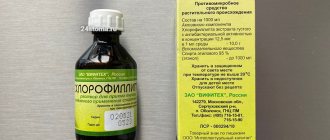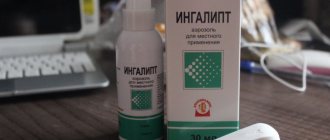From this article you will learn:
- what does Chlorophyllipt help with?
- how to dilute for gargling,
- reviews when used in ENT practice, price 2021.
The article was written by a specialist with higher medical education.
Chlorophyllipt is a herbal medicine with antimicrobial and antiseptic activity, which contains a mixture of chlorophylls from eucalyptus leaves. Chlorophyll is the pigment that gives the green color to the leaves of eucalyptus and other plants, and it is to this that the drug owes its name. The drug has the following forms of release: an oil or alcohol solution (contains ethanol), a spray form, and lozenges.
As we said above, chlorophyllipt has moderate antimicrobial activity, but it must be taken into account that it is mainly effective only against staphylococcus. Thus, the drug cannot boast a wide spectrum of antibacterial action, and it makes sense to use it primarily only as part of complex therapy. The drug also slightly stimulates regeneration processes (can be used for burns and trophic ulcers). When administered by inhalation, the drug slightly stimulates expectoration of sputum.
Chlorophyllipt: alcohol and oil solution
Chlorophyllipt spray and lozenges –
Forms of release of the drug –
- alcohol solution 1%,
- oil solution 2%,
- Spray for the throat,
- lozenges.
It should be noted that the drug has a fairly narrow range of indications for use. For example, the most popular alcohol form of the drug is not recommended for use in children under 18 years of age for oral administration (this means that the inhalation route of administration is also prohibited), as well as in pregnant and lactating women. In addition, inhalation of an alcohol solution is prohibited in case of atrophic processes in the mucous membrane of the upper respiratory tract, for example, in the atrophic form of chronic bronchitis, as well as bronchial asthma, bronchospasm.
It should be noted that Chlorophyllipt’s instructions for use of the drug are very sparse and do not contain detailed treatment regimens for diseases of the ENT organs. Therefore, patients look for information mainly on forums, where the “authors” sometimes recommend adding alcoholic Chlorophyllipt even to breast milk for newborns!!! Most of the harm has been written about the use of the alcohol form of the drug for inhalation, although courses of inhalation with alcohol solutions (especially in children) lead to atrophy of the ciliated epithelium of the bronchi, which, on the contrary, only contributes to the development of chronic bronchitis. As for the oil form of the drug, inhalations with it cannot be done in children under 2 years of age.
What is Chlorophyllipt used for?
Chlorophyllipt in tablet form is prescribed for diseases of the upper respiratory system, as well as for stomatitis. The solution is prescribed after surgery, childbirth, or infection. Indications also include:
- pneumonia;
- pleurisy;
- gynecological pathologies;
- burn disease;
- peritonitis.
Parenteral use of the drug is effective for tuberculosis and erysipelas.
The product helps with persistent wounds and soft tissue defects.
The instructions also indicate other indications for use depending on the form of the drug.
Chlorophyllipt: price and composition analysis
For Chlorophyllipt spray the price for 2021 will be about 210 rubles (for a 45 ml bottle equipped with a spray nozzle). The cost of a 2% oil solution will be from 150 rubles per 20 ml bottle. For a 1% alcohol solution of Chlorophyllipt, the price starts from 240 rubles (for a 50 ml bottle). As for lozenges, the cost of 1 package of 20 tablets starts from 150 rubles.
The drug Chlorophyllipt is produced by several manufacturers, but regardless of this, the main component of the drug always remains the extract of eucalyptus leaves - in the form of essential oil. The value of eucalyptus oil is determined by the content of a substance called “Cineol”, which gives the drug an antimicrobial and expectorant effect. Some other properties of this drug, which are beautifully described in the instructions (for example, accelerating wound healing) do not have much therapeutic value, because This effect of the drug is rather weak.
It should be noted that the content of cineole in eucalyptus oil is not constant and depends - 1) on the type of eucalyptus oil that the manufacturer uses, 2) on the concentration of eucalyptus oil in the drug solution. In addition to cineole, eucalyptus essential oil also contains other substances: chlorophyll, organic acids, aldehydes, tannins (about 6%), as well as useful trace elements, such as selenium, zinc and manganese. It should be noted that the reviews for the drug Chlorophyllipt are mostly positive, but as you will see below, the drug deserves attention only as part of complex therapy. Below we will consider in order all forms of release of this drug.
How to take Chlorophyllipt for children
The instructions for the drug do not contain clear recommendations regarding its use in childhood. The manufacturer claims that there is not yet sufficient experience in taking the medication in the treatment of children.
But since the drug is well tolerated by the body and rarely causes adverse reactions, it is often prescribed to children.
The oil solution can be used for colds and sore throat. They also have their nose dripped and their throat treated.
The solution can be used to treat wounds and cuts. In adolescence, it helps fight skin rashes.
Spray Chlorophyllipt: reviews, instructions
Chlorophyllipt-Vialine spray (manufactured in Armenia) is a combined drug for local use in the oral cavity (for the treatment of tonsillitis and pharyngitis), but can also be used to treat the nasal cavity for rhinitis. Available in 45 ml bottles with a spray nozzle. The spray is a green liquid with a characteristic odor. Does not contain alcohol.
Composition of Chlorophyllipt spray (Vialine):
| Active substances – → extracts of medicinal plants (eucalyptus leaves, stinging nettle, St. John's wort, wormwood, dubrovnik) |
| Excipients: purified water, sodium benzoate. |
→ Spray Chlorophyllipt: instructions for use (download in PDF)
Indications and regimen of use - indicated for infectious and inflammatory ENT diseases in adults (tonsillitis, pharyngitis, rhinitis). Studies have not been conducted in children, so use with caution. Make two presses on the spray nozzle, directing it to the tonsils/throat area. Apply 3 times a day. After spraying, it is advisable not to swallow saliva for as long as possible (preferably 2-3 minutes). The course of application is usually up to 10-12 days.
The official instructions also contain indications for use for stomatitis, but we do not recommend this. The fact is that the cause of aphthous stomatitis is most often an allergy, for example, to food, medications, herbal ingredients, etc. At the same time, Chlorophyllipt itself is a highly allergenic drug and can cause a worsening of the condition in some patients.
Directions for use and dosage
The oil solution, unlike the alcohol form of release, is prescribed internally and externally. For the treatment of each disease, a specific dosage regimen is used. Treating an already cleansed face with an undiluted solution helps treat acne. The procedure is repeated every 12 hours. To treat stomatitis, it is necessary to apply a tampon moistened with an oil solution to the affected area of the oral mucosa for 5-10 minutes.
The drug can be instilled into the nose, taken orally, lubricated and washed out the mucous membranes, or used as compresses on the site of inflammation. Some usage patterns:
- For burns, ulcers, long-term non-healing wounds . It is necessary to apply gauze bandages soaked in an oil solution to the affected area. The procedure is alternated with compresses based on the alcohol form of release, diluted in a ratio of 1:10.
- When affected by antibiotic-resistant staphylococci . The dosage is 5 ml 4 times daily. Take chlorophyllipt orally for 15-20 days.
- For erysipelas of the skin . Bandages or gauze soaked in an oil solution are applied to the affected area.
Chlorophyllipt in the nose
The drug showed the best effectiveness in therapy against ENT diseases. When treating sinusitis and ethmoiditis, it is necessary to take the solution 5 ml orally up to 4 times a day for 7 days. Therapy is supplemented by instilling an oil solution into the nose. The dosage for an adult is 10 drops in each nasal passage. This is approximately 0.5 pipettes. Children need to drip 2-5 drops of chlorophyllipt. They do it like this:
- you need to lie down, throw your head back;
- drip the specified amount of the drug into each nasal canal;
- After administering the medicine, lie down for another 15 minutes.
Instead of an oil solution, you can use Chlorophyllipt spray. This form is more convenient to use. For sinusitis, a child can be instilled with an oil solution only from the age of 3 years. Until this moment, cotton wool soaked in an oil solution is inserted into each nostril of the baby. They affect the nasal mucosa. The procedure can be performed 2-3 times a day until the symptoms of the disease decrease. For older children, nose drops are instilled at intervals of 6 hours. Do not use the drug for allergic rhinitis or severe swelling of the nasal mucosa.
Laryngobronchitis in adults is treated by taking an oil solution orally. The dosage is 5 ml up to 4 times a day for 7-10 days. Uncomplicated nasal furunculosis is treated as follows:
- first apply bandages moistened with a one percent alcohol solution diluted 1:10;
- then they do the same, only they use an oil solution, changing the dressings 2-3 times a day.
Chlorophyllipt oil for throat
To treat a sore throat, the doctor prescribes treating the throat, including the inflamed mucous membrane of the tonsils. To do this, use cotton swabs soaked in a solution. In addition to lubricating the tonsils, resorption of eucalyptus extract in tablets, rinsing with an alcohol solution and inhalation using a nebulizer are prescribed. For inflammatory diseases of the bronchi or throat, the dosage of the oil form is 20 ml.
The drug is taken orally, dividing the indicated amount by 4 times. This amounts to approximately 1 teaspoon per dose. The duration of the course of treatment is 7-10 days. Treatment of the throat to reduce pain is carried out as follows:
- first take a chlorophyllipt tablet;
- then rinse with an alcohol solution (when rinsing, you can also use Furacilin);
- After this, treat the mucous membranes of the throat with the oil form of the drug.
In gastroenterology
When treating stomach ulcers in adults, chlorophyllipt is prescribed as part of complex therapy. The medicine is taken one teaspoon three times a day. The course of treatment lasts about 3 weeks, then there is a three-month break. The cycle can then be repeated. The procedure is as follows:
- the first - on an empty stomach, an hour before breakfast, you need to dissolve 1 teaspoon in 30 ml of water;
- the second - 4 hours later, again an hour before meals, the dose remains the same;
- the third - before bed, 2 hours after eating, the same dosage.
For stomach ulcers, the drug is additionally administered using an endoscope directly to the affected area. The procedure is repeated daily for 10 days. The oil solution is used to lubricate the tip of the balloon before performing medicinal enemas or in case of local complications necessary for the treatment of sphincteritis or hemorrhoids.
- Fitness at home - video with exercises for weight loss. Home fitness video tutorials
- Floor standing air conditioner for home without duct
- Chinese chicken: recipes
Chlorophyllipt in gynecology
For women during lactation, the drug is recommended for application to the nipples after feeding to prevent cracks. Before the next time, wash off the solution with boiled water. To treat cervical erosion, it is necessary to use a tampon soaked in chlorophyllipt. The medicine is injected directly into the vagina and left for 15-20 minutes. The procedure is carried out for 10 days, then douching is used. Here the treatment regimen changes:
- It is necessary to prepare a solution for douching by mixing a tablespoon of oil solution with a liter of water.
- After the procedure itself, a tampon moistened with undiluted drug is inserted into the vagina. He is left there for 12 hours.
- The course lasts 2 weeks. If, at the end of the procedure, the cervix is not completely epithelialized, then the cycle of procedures is repeated again.
Side effects, contraindications –
It is possible to be allergic to chlorophyll or other components of eucalyptus oil. Use with caution in people with allergic reactions. Ingestion of high dosages of the drug can lead to vomiting, diarrhea, nausea, and muscle spasms. Frequent/long-term use of the drug for inhalation can lead to thinning and dryness of the mucous membranes of the respiratory system, atrophy of the bronchial mucosa (with the development of chronic atrophic bronchitis).
Under no circumstances should the drug be used by inhalation for bronchial asthma, bronchospasm, asthmatic bronchitis, chronic atrophic bronchitis. There are contraindications for use in the oil form for inhalation - in children under 2 years of age, and in the alcohol form - in children under 18 years of age. Cannot be used orally for hyperacid gastritis. An alcohol solution should not be used for rinsing if the mucous membrane of the mouth and throat is dry and thin (24stoma.ru).
Important: before starting to use any form of Chlorophyllipt, you must first check the body's sensitivity to this drug. To do this, the patient must dissolve 25 drops of Chlorophyllipt alcohol solution in 1 tablespoon of water and drink. Or take 10 drops of oil solution. If after 6-8 hours there is no allergic reaction, you can start using the drug. An allergic reaction can also manifest itself on the skin.
Clinical studies of Chlorophyllipt –
As a well-educated doctor who reads a lot of scientific research, I would like to add a few more words. You will be surprised, but in the scientific literature you will not find a single clinical scientific article devoted to Chlorophyllipt, as well as not a single decent clinical study that would involve a comparison with a control group (placebo). All the information that can be found is mainly on the development of chlorophyll-based drugs (on behalf of pharmaceutical companies). All that was found was a scientific article devoted in general to the antimicrobial activity of chlorophylls, of which Chlorophyllipt is also composed.
The article “Antimicrobial activity of preparations containing chlorophylls” was published in 2013 (edited by Zhumabekov S.A. and Aisanov A.K.). It is worth noting that the article seriously argues that the antimicrobial activity of chlorophylls is comparable to antibiotics, but it does not provide a single comparative clinical study or any other evidence-based argumentation. Thus, it can be stated that from the point of view of evidence-based medicine, the effectiveness of the drug is in question. We hope that our article was useful to you!
Sources:
1. “Otorhinolaryngology. Textbook" (Palchun, Magomedov), 2. "Propaedeutics of internal diseases" (Grebenev A.L.), 3. Scientific works published on the website - https://cyberleninka.ru/, 4. https://ru.wikipedia .org/, 5. https://www.vidal.ru/.
Analogs
Chlorophyllipt has a number of analogue drugs that are close to it in composition or principle of action. You can replace one medicine with another only as prescribed by a doctor. Analogs of chlorophyllipt are:
- hydrogen peroxide;
- Chlorophyllin-Oz;
- ManiSoft;
- Ichthyol;
- Biosept;
- Antiseptol;
- Extericide;
- Fukortsin;
- Septil Plus;
- Vitasept;
- Galenophyllipt;
- Eucalymin.




